What the blackberry is usually called “berry” is not really a berry. This type of fetus is referred to as a collective drupe. A blackberry flower is a multi-pest, and around each pistil is formed a small, juicy fruit with one seed inside. The set of these fruits, gathered together, is the very tasty and fragrant blackberry.
Combined drupes are formed in many plants. Some of them, in their bluish-black color, are so similar to blackberries that they introduce the uninitiated to the delusion. Plants whose fruits resemble blackberries are discussed in this review.
Table of contents
Black raspberry look like a blackberry
This plant in Russian gardens is still exotic. In appearance, it is, indeed, easy to confuse with blackberries: a shrub, with thorny shoots and leaves typical for raspberries and blackberries. The fruits of black raspberry when ripe change color from pink, through dark red, to black. And they taste a bit like blackberries.
And yet, there is a difference: when collecting, black raspberry drupes are easily removed from the fruit tree - like a thimble from a finger. Similarly, the usual red or yellow raspberry behaves. In the blackberry, however, the crop is harvested together with the fruit and the stem, because its drupes densely grow together with their place.
At the beginning of the 19th century, this plant began to be introduced into the culture by N. Lonagwart. In the US, black raspberries quickly became popular. Through the efforts of breeders, her varieties of Remontant were bred from Ohio, Evans, Dundee, Bristol.
In Russia today, two varieties of black raspberries are cultivated: Cumberland and Coal.
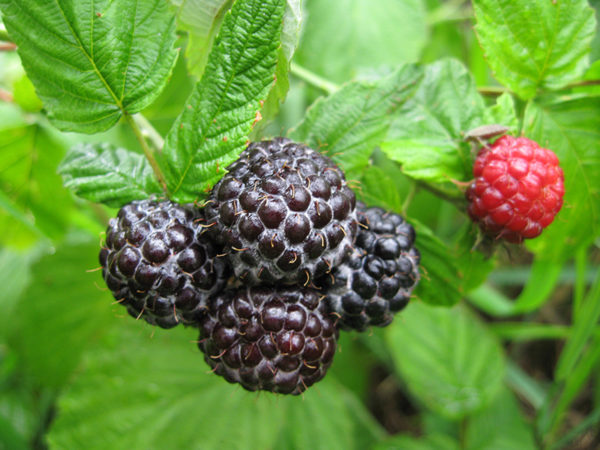
Raspberry cumberland
This is a very old variety of American selection.It was received at the end of the 19th century by D. Miller, and quickly moved to Europe. Until recently, Cumberland was the only black variety known in Russia. In our gardens, it got accustomed due to the undoubted dignity - high frost resistance (up to -30С).
Cumberland forms a powerful bush with a length of shoots up to three meters. Shoots with a large number of thorns, grow in the type of half-spreading blackberry: initially erect, they grow in an arcuate manner as they grow. The tops at the same time, reaching the ground, are able to take root. Therefore, Cumberland, although it does not give root offspring, but it can “walk” around the site.
Cumberland looks especially decorative in the fall. At this time, his shoots become an exotic gray-blue color. Thanks to such qualities, it is possible to form a hedge from Cumberland, which will be both “tasty”, and beautiful, and reliable.
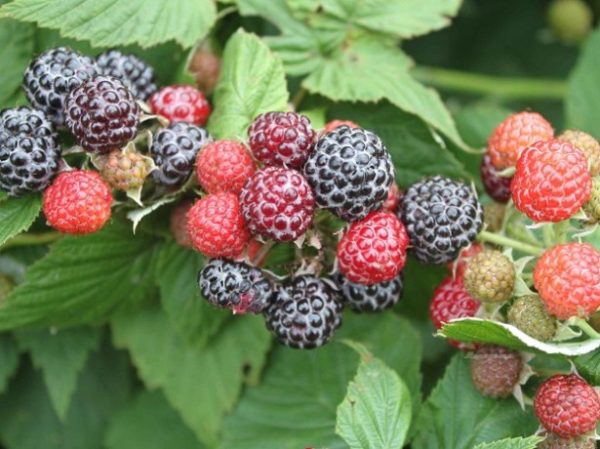
Raspberry Ember
The tradition of American breeders picked up by Russian scientists from the Institute of HorticultureSiberia. Variety Ugolek was introduced recently and recommended for cultivation in the territory from the Urals to the Far East.
The raspberry bush, which is called Charcoal, is more compact than Cumberland's. Shoots are not studded so heavily, on average 2.3 meters in length, half-cello. Annual lashes of green color with a bluish bloom. Biennial - brown-gray.
The fruits of raspberry Ember small, 1.8-2 grams. In good conditions, the variety gives about 8 kg per bush. By the time of ripening, the Charcoal is considered medium early, the harvest gives more or less amicable - within two weeks.
Serious advantages of the variety are high winter hardiness and disease resistance.
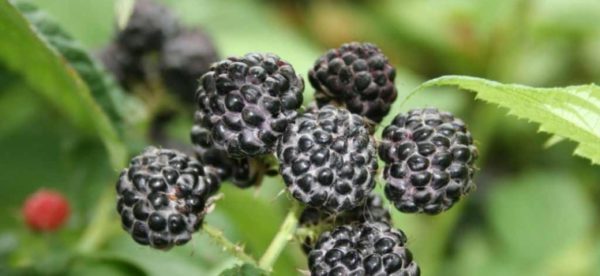
Berry Mulberry
Juicy mulberry looks very similar to the fruit of the garden blackberry. The same slightly elongated shape, the same purple-black color. True, this plant is not only black, but also white. And yet it is black mulberry that is most often cultivated for eating (she is a mulberry tree).
You can confuse mulberry with blackberry only by looking at the fruit.Her taste is completely different, unlike anything, very sweet, with an unusual aroma and aftertaste. And the morphology of the plant is quite different. This is not a shrub, but a tall tree (up to 20 meters), sometimes growing in several trunks. For the convenience of cultivation, the cultured mulberry is formed with a 1.5-meter shtamb - in this case it does not outgrow above 4 meters.
Of the most popular mulberry trees can be noted an interesting variety Shell N150. The name comes from the first syllable of the word "mulberry" and the initials of the creator of the variety Leonid Ilyich Prokazin. The fruits of this plant are of excellent taste and reach a length of 5.5 cm. Shelley's sheet plate is gigantic, 0.5 in length.
The black-fruited mulberry tree is very thermophilic. In Russia, it is grown in the North Caucasus and in the Lower Volga region, where it is often found in its wild form. Surprisingly, in the middle zone, the mulberry is sometimes cultivated very successfully.
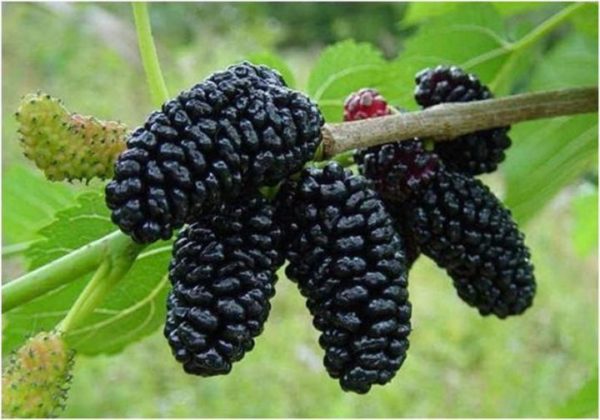
Mulberry Darkie
For the climate of the central region may be suitable variety Darkie. Very pleasant to the taste, slightly acidic fruits Dark-skinned women have a length of 3 cm and ripen very early. Already in June, you can try the first harvest.And the yield of this plant pleases the gardener's heart - 0.5 kg of mulberry is collected from each meter of fruitful branch.
An important advantage of the variety is a high degree of adaptation to cold and short summer. Mulberry Darkie quite easily restored when freezing shoots. This contributes to an interesting feature of the plant - a tendency to run over. With an early cold snap, the matured part of the branch forms a cork separating layer, discarding the underexposed part, like a lizard's tail.
However, too severe and prolonged frosts have a bad effect on productivity. Therefore, it is better to secure the Darkie with shelter. To do this, it is necessary to form it so that the crown height does not exceed two meters, and with the onset of cold weather, tie the plant with spunbond in several layers.
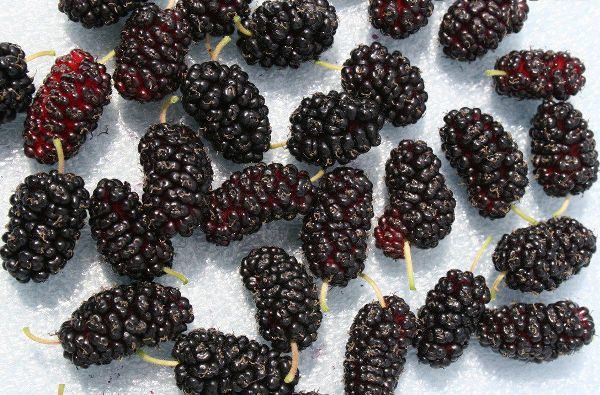
Plant Berry Laconos
Extremely rare in our latitudes, a plant that surprises with exotic stems. Segmented juicy black fruits on long “cobs” look like blackberries.
This herb is a plant of the Phytolacca family, originally from North America. Perennial, annually producing several thick stems, up to 1.5 meters. Long erect inflorescences of laconos appear at the end of May and vaguely resemble the blooming of hyacinths. Many greenish-pink flowers give the plant a very decorative look.
The fruits of berry laconosa ripen by the end of summer. By this time, the fruitful becomes red in color, and on its background black “blackberries” look amazingly spectacular. The juice of this plant has a rich dense scarlet color.
As Paracelsus said, "everything is poison, and everything is medicine." Lakonos, indeed, recognized as a poisonous plant. Allow children or pregnant women to feast on black berries in any case is impossible. And adults need to treat them with great caution. Many cases of severe cardiac arrhythmias associated with the use of laconosa are described.
And yet you can try to find practical application for this interesting plant. Traditional medicine knows the recipe from roots of lacunosa, which can alleviate rheumatic pains.
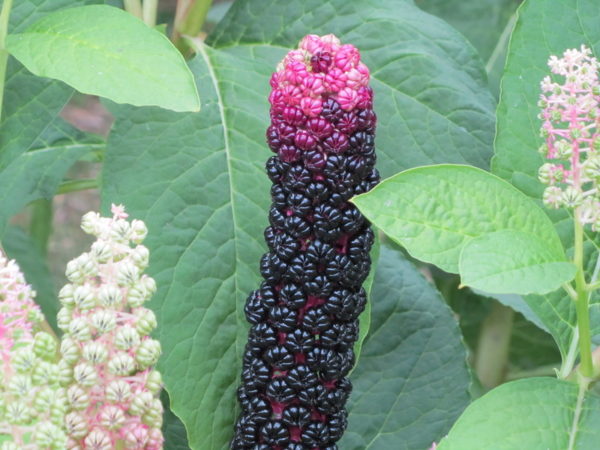
Ingredients:
- 0.5 cups of Laconosa roots;
- 1 cup vegetable oil or kerosene.
Chop the roots, mix with the base and insist in a dark place for ten days. The resulting tool to rub the aching joints.
In the list of berries, similar to blackberries, it would be possible to mention the spring. For example, very popular varieties Loganberry, Taberri or Michurinsky Progress. But emalin is still almost a blackberry, a product of hybridization. Therefore deserves a completely separate conversation.
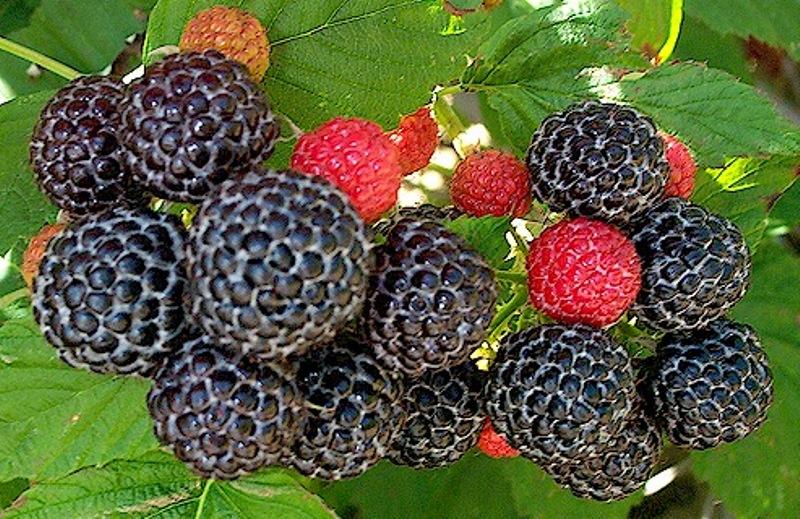
Thank you for the article! Thanks to her, I found the name of the unidentified on the site of the plant - Lakonos berry. And the poor Gugule could not pick up the pictures.
Thank you again! 🙂